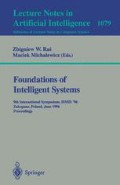Abstract
When modeling expertise from multiple experts, expertise conflicts among the expertise models of the different experts must be tackled, so as to build their common expertise model. The domain level of an expertise model can be represented using Sowa's conceptual graph formalism. This paper presents a method for conflict management during knowledge modeling from multiple experts: this method is based on the comparison and integration of multiple conceptual graphs corresponding to different viewpoints, the integration being guided by different integration strategies.
Preview
Unable to display preview. Download preview PDF.
References
M. Chein, and M. L. Mugnier. Conceptual Graphs: Fundamental Notions. RIA, 6(4):365–406,1992.
O. Cogis, and O. Guinaldo. A Linear Descriptor for Conceptual Graphs and a Class for Polynomial Isomorphism Test. In G. Ellis et al, eds, Conceptual Structures: Applications, Implementation and Theory, Springer-Verlag, LNAI 954, pp. 263–277, Santa Cruz, CA, Aug. 1995.
R. Dieng. Conflict Management in Knowledge Acquisition. In I. Smith (Ed), AIEDAM, Special Issue on Conflict Management in Design, 9(4):337–351 September 1995.
R. Dieng, O. Corby, and S. Labidi. Expertise Conflicts in Knowledge Acquisition. In B. Gaines, and M. Musen, eds, Proc. of KAW-94, pp. 23-1–23-20, Banff, Canada, Jan.–Feb. 1994.
R. Dieng, O. Corby, and S. Labidi. Agent-Based Knowledge Acquisition. In L. Steels et al, eds A Future for Knowledge Acquisition: EKAW'94, Springer-Verlag, LNAI 867, pp. 63–82, Sept. 1994.
R. Dieng. Comparison of Conceptual Graphs for Modelling Knowledge of Multiple Experts. INRIA Research Report, February 1996.
S. Easterbrook. Handling conflict between domain descriptions with computer-supported negotiation. Knowledge Acquisition, 3(3):255–289, September 1991.
S. M. Easterbrook. Distributed Knowledge Acquisition as a Model for Requirements Elicitation. In Proc. of EKAW-89, pp. 530–543, Paris, France, July 1989.
J. Eggen, A. M. Lundteigen., and M. Mehus. Integration of Knowledge from Different Knowledge Acquisition Tools. In B. Wielinga et al. eds, Proc. of EKAW-90, Amsterdam, Feb. 1990. IOS Press.
B. R. Gaines, and M. L. G. Shaw Comparing the Conceptual Systems of Experts. In Proceedings of the 9th IJCAI (IJCAI-89), pp. 633–638, Detroit, 1989.
C. Garcia. Construction coopérative d'ontologies dans un cadre de multi-expertise. Rapport de stage de DEA Informatique, LIRMM, Montpellier, September 1995.
M. M. Kayaalp and J. R. Sullins Multifaceted Ontological Networks: Reorganization and Representation of Knowledge in Natural Sciences. In Proc. of KAW-94, pp. 25-1–25-19, Banff, Canada, Jan.–Feb. 1994.
M. Klein. Detecting and resolving conflicts among cooperating human and machine-based design agents. Artificial Intelligence in Engineering, 7:93–104, 1992
G. W. Mineau, and M. Allouche. Establishing a Semantic Basis: Toward the Integration of Vocabularies. In Gaines et al eds Proc. of KAW'95, pp. 2-1–2-16, Banff, Canada, Feb. 1995.
K. S. Murray, and B. W. Porter. Developing a tool for knowledge integration: initial results. International Journal of Man-Machine Studies, 33:373–383, 1990.
A. Newell. The knowledge level. Artificial Intelligence, 18:87–127, 1982.
J. Poole, and J. A. Campbell. A Novel Algorithm for Matching Conceptual and Related Graphs. In G. Ellis et al eds, Conceptual Structures: Applications, Implementation and Theory, pp. 293–307, Santa Cruz, CA, USA, August 1995. Springer-Verlag, LNAI 954.
M. Ribière, R. Dieng, M. Fornarino, A.-M. Pinna-Dery. Intégration d'un formalisme de liens dans le formalisme des graphes conceptuels. INRIA Research Report, February 1996.
M. L. G. Shaw, and B. R. Gaines. A methodology for recognizing conflict, correspondence, consensus and contrast in a knowledge acquisition system. Knowledge Acqu., 1(4):341–363, Dec. 1989.
J. F. Sowa. Conceptual Structures: Information Processing in Mind and Machine. Reading, Addison-Wesley, 1984.
J.F. Sowa. Conceptual Graphs Summary. In T.E. Nagle et al, eds Conceptual Structures: Current Research and Practice, England, Ellis Horwood Workshops, 1992.
J.F. Sowa. Relating Diagrams to Logic. In Proc of ICCS'93, Québec City, Canada, August 1993.
G. Wiederhold. Interoperation, Mediation and Ontologies. Proc. of FGCS'94 Workshop on Heterogeneous Cooperative Knowledge Bases, Tokyo, Japan, pp. 33–48, Dec. 1994.
B. Wielinga, G. Schreiber, and J. Breuker. KADS: a modelling approach to knowledge engineering. Knowledge Acquisition, 4:5–53, 1992.
M. Willems. Projection and Unification for Conceptual Graphs. In Ellis et al eds, Conceptual Structures: Applications, Implementation and Theory, pp. 278–292, Santa Cruz, Aug. 1995. Spring.-Verl., LNAI 954.
Author information
Authors and Affiliations
Editor information
Rights and permissions
Copyright information
© 1996 Springer-Verlag Berlin Heidelberg
About this paper
Cite this paper
Dieng, R. (1996). Comparison of conceptual graphs for modelling knowledge of multiple experts. In: Raś, Z.W., Michalewicz, M. (eds) Foundations of Intelligent Systems. ISMIS 1996. Lecture Notes in Computer Science, vol 1079. Springer, Berlin, Heidelberg. https://doi.org/10.1007/3-540-61286-6_133
Download citation
DOI: https://doi.org/10.1007/3-540-61286-6_133
Published:
Publisher Name: Springer, Berlin, Heidelberg
Print ISBN: 978-3-540-61286-5
Online ISBN: 978-3-540-68440-4
eBook Packages: Springer Book Archive

